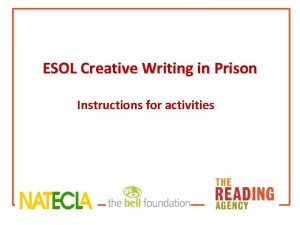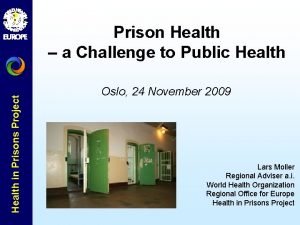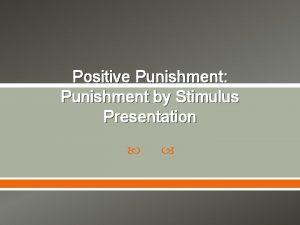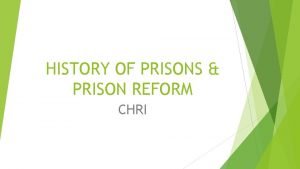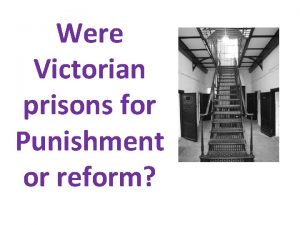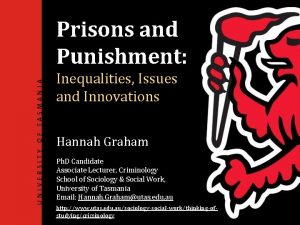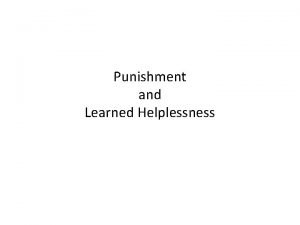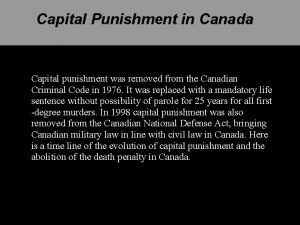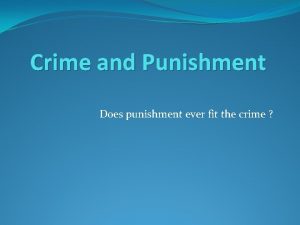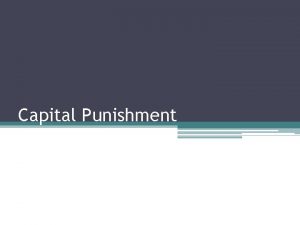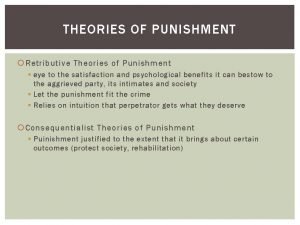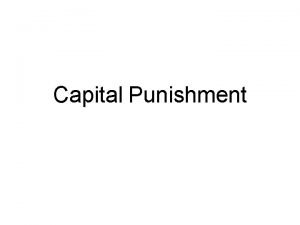The delivery of punishment Prisons play an important

















- Slides: 17

The delivery of punishment Prisons play an important part in delivering the state’s response to crime. Here we will consider their role and operations. © 2018 Peter Joyce

The role of prisons – eighteenth and nineteenth centuries • Under the influence of utilitarian and evangelical reforms in the late eighteenth and early nineteenth centuries, prisons were seen as institutions both to punish offenders and to reform criminals. • During the mid-nineteenth century, the deterrence of crime assumed prime position, resulting in harsh custodial regimes. Their key role became that of protecting the public. © 2018 Peter Joyce

The role of prisons – the Gladstone Report • The 1895 Gladstone Report argued that the emphasis on deterrence should be balanced with a similar emphasis on rehabilitation (whereby the state should play a positive role to bring about changes to the habits of offenders). • The report argued that wrongdoers were sent to prisons as rather than for punishment. • It was thus instrumental in initiating a movement away from harsh conditions, giving rise to what was known as the treatment model. © 2018 Peter Joyce

Decline of the treatment model • Influenced by the ‘nothing works’ arguments put forward by Martinson (1974) and a ‘new right’ political imperative of being seen to get tough with offenders, the rehabilitative ideal embraced by the treatment model gave way to a retributivist philosophy. • This was summarised by the intention of ‘getting tough with criminals’. • The aim of reforming offenders was not totally abandoned – but it was downgraded to becoming a secondary aim of imprisonment. © 2018 Peter Joyce

Why did prisons find it hard to rehabilitate offenders? • One reason to explain why reform and rehabilitation became downgraded as the main aim of prison was that they were failing to turn a prisoner’s life around. • Accordingly, most persons who received a custodial sentence went on to re-offend when they were released (recidivism). • It was thus argued that prisons were an expensive way of making bad people worse. © 2018 Peter Joyce

Why was this the case? • The failure of prisons to enable the majority of inmates to leave and henceforth lead lawabiding lives was undermined by a number of factors. • These included the nature of the prison environment, the effectiveness of measures to enable prisoners to transform their lives and the characteristics of those who received custodial sentences. © 2018 Peter Joyce

The prison environment One reason that explained the high level of recidivism was that the prison environment made reform/rehabilitation a difficult ideal to accomplish in practice. This was/is not conducive to reforming inmates for reasons that include: • Prisoners may find it difficult to cope with confinement and experience personality changes and psychological deterioration. • The emphasis on security (especially in times of overcrowding) may reduce the availability of purposeful activities that may aid rehabilitation. • The violent nature of prison regimes may result in brutalising prisoners, making them worse than when they went in. • Prisons may serve as ‘universities of crime’ – institutions in which inmates build contacts that will be used to continue criminal careers upon release. © 2018 Peter Joyce

Also. . . • Activities that are designed to make ‘bad people better’ (education, work training, programmes to address offending behaviour etc. – collectively referred to as ‘purposeful activities’) are not effectively delivered – especially to those receiving short sentences. • Numerous factors related to the background of prisoners (including health [especially mental health] issues, poor education and home life styles) are not conducive to reform/rehabilitation. • Labelling theory may aggravate the existing impediments to a prisoner ‘going straight’. © 2018 Peter Joyce

The new approach (1993– 1997) • The goal of rehabilitation gave way to one of retributivism – a philosophy enunciated by Michael Howard at the October 1993 Conservative Party Conference. • He stated that prison works. © 2018 Peter Joyce

‘Prison works’ • The desire to get tough with criminals promoted prisons as the cornerstone of Conservative government penal policy. • Prisons ‘worked’ in the sense that they provided tangible proof that wrongdoers were being apprehended and punished and also by removing offenders from communities, thus protecting the public. • This approach led to a dramatic rise in the prison population in 1993 that has been subsequently sustained. • The regime within prisons also became harsher (‘decent, but austere’): the introduction of mandatory drug tests were one aspect of this. © 2018 Peter Joyce

But did this new approach work? (1) • Harsh regimes may promote disorder within prisons. © 2018 Peter Joyce

The Woolf Report (1991) • The investigation into the Strangeways prison riot was conducted by Lord Woolf. • In his report he emphasised the importance of balancing security, control and justice within prisons in order to maintain order. • This might suggest that perceptions of injustice within prisons may divert a prisoner’s energies into rebellion rather than reform/ rehabilitation. © 2018 Peter Joyce

But did the new approach work? (2) • Overcrowding became a significant problem after 1993. • It remains a significant problem today, aggravated by post-2010 spending cuts. • Overcrowding leads to prisoners being locked in their cells for lengthy periods of time as security becomes the pre-eminent concern of prison staff. • The ability of prisoners to benefit from purposeful activities is accordingly reduced. © 2018 Peter Joyce

Post-1997 prison policy • The 1997 general election witnessed a change of government. • The new government placed emphasis on ‘constructive’ prison regimes and Home Secretary Charles Clarke (2004– 2006) placed tackling re-offending at the heart of his law and order agenda – hence the creation of the National Offender Management Service in 2004. © 2018 Peter Joyce

Post-2010 prison policy • The 2010 Coalition government promised a ‘rehabilitation revolution’, a theme picked up by the 2015 Conservative government. • But despite rhetoric and reforms that have included the designation of many institutions as ‘resettlement prisons’, this goal seems far off – and achieving it has not been aided by post-2010 public sector spending cuts. © 2018 Peter Joyce

The current prison crisis Currently prisons are in a state of crisis. • 2016 witnessed over 100 suicides in prison. • Disorder within prisons is a problem, evidenced by assaults on staff and riots (e. g. HMP Bedford and HMP Birmingham, 2016). • Drug taking is rife. • Strategies used to secure order maintenance by prison staff may lead to views that the inmates run these institutions. © 2018 Peter Joyce

References / further reading • Cavadino, M. , Dignan, J. and Mair, G. (2013) The Penal System: An Introduction, 5 ed. London: Sage. • Gladstone, H. (1895) Report from the Departmental Committee on Prisons, Sessional Paper 1895, c. 7702. London: HMSO. • Howard, M. (1993) Speech to the Conservative party conference, Blackpool, 6 October. • Martinson, R. (1974) ‘Questions and Answers about Prison Reform’, Public Interest, 34: 22– 54. • Scott, D. and Flynn, N. (2014) Prisons and Punishment. The Essentials, 2 ed. London: Sage. • Woolf, Lord (1991) Prison Disturbances 1990: Report of an Inquiry by the Rt. Hon. Lord Justice Woolf (part I and II) and His Honour Judge Stephen Tumim (part II), Cm 1456. London: HMSO. © 2018 Peter Joyce
 Wjec criminology unit 4 grade boundaries
Wjec criminology unit 4 grade boundaries Esol prisons
Esol prisons Token economy examples for adults
Token economy examples for adults Adx florence famous inmates
Adx florence famous inmates Health in prisons project
Health in prisons project Components of ads accenture delivery suite
Components of ads accenture delivery suite Least important to most important
Least important to most important From most important to least important in writing
From most important to least important in writing Inverted pyramid in news writing
Inverted pyramid in news writing Forecasting plays an important role in
Forecasting plays an important role in The mass media play an important part in our lives
The mass media play an important part in our lives The mass media play an important
The mass media play an important I've got a friend we like to play we play together
I've got a friend we like to play we play together Play random play basketball
Play random play basketball Hamlet
Hamlet Play by play
Play by play Tỉ lệ cơ thể trẻ em
Tỉ lệ cơ thể trẻ em Thế nào là mạng điện lắp đặt kiểu nổi
Thế nào là mạng điện lắp đặt kiểu nổi

